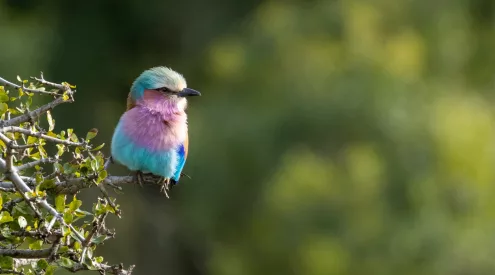On assignment in the wilderness of Botswana, photographer and videographer Kevin MacLaughlin came across one of the most ferocious predators in Africa. Guillotine-like teeth, powerful claws, and a death rattle like a Dementor, the honey badger certainly keeps its enemies at bay.
With a name as innocent as ‘honey badger’, one wouldn’t assume this short and stout carnivore is after anything more vicious than bees, but one shouldn’t let the interpretation of its ancient, scientific name (Mellivora capensis: Mel meaning ‘honey’ and voro meaning to ‘devour’) get in the way of one’s understanding of this beast. Sure, its natural ability to sniff out honeycomb and tolerate the stings of thousands of angry bees makes it pretty tough, but its skin is just under a centimetre thick and it can withstand the venom of a cobra.

The aposematic colouration of the white ‘saddle’ is a deterrent for potential predators. Cheetah cubs exhibit this same mantle of white fur at a certain age, which imitates a honey badger and in doing so, protects them from potential threats. Photo by Kevin MacLaughlin.
Kevin’s experience at Camp Linyanti was with a baby honey badger. Their lifespans can reach up to 20 years and without any real predators, and enjoying such a varietal diet, honey badgers can be confident in a long life.
In the shady woodlands of the Linyanti marsh in north-western Chobe National Park, great herds of elephants gather in unbelievable abundance. In this day and age of conservation, it is quite something to witness the massive herds that move to the permanent waters of the Linyanti swamps during the dry, winter season. Water-lovers like the lechwe, sitatunga, hippo, buffalo, sable, and zebra join the giant pachyderms, as do an unbeatable population of birds, and of course, the predators that hunt the prey.

Northern Botswana’s specialised red lechwe has noticeably higher hindquarters, designed for powering through deep water and swampland. Photo by Kevin MacLaughlin.

An elephant chasing a pesky baboon. Photo by Kevin MacLaughlin.

Little bee-eater – a common pop of colour in the Linyanti. Photo by Kevin MacLaughlin.
Lion, leopard, cheetah, hyena, and the endangered African wild dog are the larger carnivorous counterparts, making the honey badger seem rather unthreatening in comparison. Do not be fooled! Known to target the groin of big mammals, honey badgers have developed unique defence strategies that have proved highly successful in keeping bigger-toothed animals at bay. Smelly anal gland secretions add to its ball-biting repertoire… beware.

A lioness of the Linyanti. Photo by Kevin MacLaughlin.
Kevin was armed with his video camera when he chanced this meeting with the lone, baby honey badger, and a smart bit of filming has given us an intimate look at their interaction just outside the utopic, Camp Linyanti. Starting off rather cute and fluffy, the young ‘ratel’ (as they are known in Afrikaans) soon showed Kevin who’s boss and revealed its true, unruly attitude.
Take a look at the footage Kevin captured of this fiery fighter:
Linyanti sound like your cuppa tea? Visit Camp Linyanti’s website for more.

















